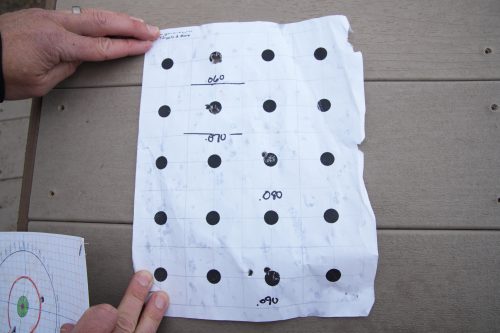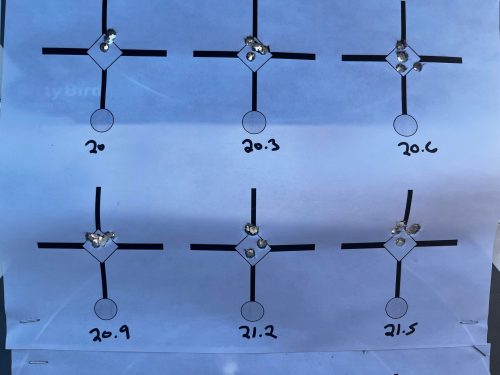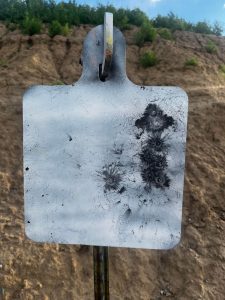To say 223 Remington / 223 Wylde is a popular cartridge would be a huge understatement. From varmint hunting to a slue of competition formats and range/training rifles, the .223 can really do it all.
This 223 Wylde started as a project to get the Pikes Peak Precision monthly club match a loaner rifle for shooters looking to dip their toes into PRS style shooting. We are running an Impact Precision NBK action with a Bartlein 7.5” twist M24 contour barrel chambered by Blue Mountain Precision.
It sits in a PSE Stocks E-Tac stock with a tall/long latch Hawkins M5 DBM, Bix’N Andy TacSport trigger and a Henderson Precision Universal ARCA Rail. All stock work was done by Flatline Precision out of Colorado Springs, CO.
The rifle sports an Element Optics Theos 6-36×56 rifle scope in a set of Ultra-Light Tactical scope rings. For match use the rifle will be running a Hawkins Tank ST brake, but for load development on a private range we used a Thunder Beast Arms Ultra 7 suppressor.
For this rifle we will be running Hodgdon H4895 powder, Berger 85.5 grain Long Range Hybrid Target bullets, Federal AR Small Rifle Match Primers, and Wolf Brass. (More on that later.)
We are also using MDT polymer and metal .223 REM magazines with a max COAL of 2.50”, which can come into play with these long for caliber bullets, depending on the chamber.
Seating Depth Testing –
 The first thing I like to do for load development is seating depth testing. We have a good video on the Hawkins YouTube channel covering how to find the distance to your lands via the Hornady OAL gauge and a Sinclair Hex comparator. The distance to the lands with my particular set-up and lot of bullets is: 2.8215”. (Note that dimension includes the comparator.)
The first thing I like to do for load development is seating depth testing. We have a good video on the Hawkins YouTube channel covering how to find the distance to your lands via the Hornady OAL gauge and a Sinclair Hex comparator. The distance to the lands with my particular set-up and lot of bullets is: 2.8215”. (Note that dimension includes the comparator.)
The reason we test seating depth first is depending on how far off the lands you are, it creates different pressure variable in your rifle. Closer to the lands equals more pressure, which equals more velocity. If we set charge weight before settling on seating depth, then we’re moving the mark again on charge weight and pressure.
I use the same method outlined by Precision Rifle Blog where a shooter would jump bullets more to keep a more consistent load throughout the life of the barrel. (Article Link) You can see in the article that Berger 105 hybrids like .060 off all the way out to .090”. I have run tens of thousands of 105s like this and know they work well.
However, with an 85.5 grain bullet in a 223 Wylde, that eats up a lot of case capacity. I still wanted to test at a .060” jump and beyond though. We started at the classic .020” then went to .060 – .090” in five shot groups with a safe load of 20 grains of H4895. We did not measure velocity with these groups.
Group Size Testing at 100 yards:
.020” – .564” Group
.060” – .435” Group
.070” – .498” Group
.080” – .532” Group
.090” – .651” Group
Of the groups, .060” off shot well. However, on a subsequent range trip with some leftover ammo I chronographed the 20.0 grain H4895 load, which yielded all of 2,400 FPS in the rifle. This was a little surprising. From the first range trip I had already almost made up my mind to eat up some case capacity for the accuracy. However, 2,400 was a little slower than expected.
Either way, I wanted to test charge weights at .060” and see if we could make a little more speed without sacrificing all day reliability.
 Charge Weight and Accuracy Testing – .060” off
Charge Weight and Accuracy Testing – .060” off
We started at the initial load of 20.0 grains and went up from there. Here’s what we came up with at 100 yards.
20.0 – 2,425 fps / SD 10 / .400” Group
20.3 – 2,445 fps / SD 6.8 / .420” Group
20.6 – 2,475 fps / SD 11.9 /.551” Group
20.9 – 2,500 fps / SD 9 / .420” Group
21.2 – 2,550 fps / SD 11 / .563” Group
21.5 – 2,570 fps / SD 5.6 / .503” Group
21.8 – 2,600 fps / SD 9 / .651” Group (heavy-ish bolt lift)
22.0 – 2,640 / SD 6 / No Group – 3 Fail to fires. Not safe in this rifle.
Looking over the data, 20.0, 20.3 and 20.9 really stuck out and all had consistent grouping at 100 yards. If I was running this rifle personally with these components, I would likely take a hard look at 20.9. Choosing accuracy at distance for a strictly match rifle.
But what happens when we go out to .020” off and gain some of that case capacity back?
Charge Weight and Accuracy Testing – .020” off
Running .020” off the lands immediately gets us to the max COAL of the MDT 223 magazines, not leaving much more room to test closer to the lands. Thus, this is about as long as we can run in the current set-up. We ran from 21 grains up to 22. Please note, book max from Hodgdon on a 90 grain SMK is 21.5. Run up to these numbers with caution.
21.0 – 2,550 fps / SD 15 / .568” Group
21.2 – 2,571 fps / SD 2.6 / .668” Group
21.4 – 2,602 fps / SD 18.1 / .401” Group
21.6 – 2,613 fps / SD 7.4 / .580” Group w/ flier. .333” without
21.8 – 2627 fps / SD 6.5 / .530” Group (Slight heavy bolt lift)
22.0 – 2,650 fps / SD 7.6 / .403” Group (Click at top – Pressure)
From 21.4 grains to 21.8 grains the rifle was shooting really well and we’re getting a bump in velocity. As the throat wears on this barrel will we see the accuracy degrades without chasing the lands. Since I’m at about max COAL on the magazines I will need to keep an eye out on how much the lands are eroding. Thankfully a mild load .223 should not be too hard on the barrel.
After it was all said and done, I went with the 21.4 grain load. The group was good, and it keeps away from any pressure signs we saw at 21.8 and 22 grains.
 Accuracy at Distance –
Accuracy at Distance –
Day 1 –
After looking over the numbers there was only one thing left to do, pick two loads and see how they shot at distance. First up was the 20.9 load with a .060” jump. The horizonal spread on the group was overall great, but you can see the vertical in the photo is about 6-7” on a 12” plate at 550 yards.
After shooting more rounds the Wolf brass’ weight/capacity variation really stands out at distance as well as the SD. The Wolf brass, which theoretically all came from the same lots, went from 91 grains to almost 95 grains spot checking and weight sorting. Something that really makes a difference on a low case capacity cartridge.
The second test was the .020” / 21.4 load going 2,600 fps. After shooting the .060” / 20.9 grain load in good conditions, I quickly got into an Eastern Colorado shifting, 15 mph headwind as the day warmed up and the horizontal and vertical spread on the target gave no indication of the accuracy the rifle was capable of due to the conditions and brass quality.
 Day 2 –
Day 2 –
We headed back out with some freshly loaded ammo and weight sorted brass. It was time to see what 21.4 / .020” off would do for us. Conditions were great in the early morning, and we put down a 5.153”, 10 shot group at 550 yards on a 12” plate. (0.895 MOA) Pretty hard to beat for a PRS loaner rifle.
Final Thoughts
The 223 Wylde load development really took a lot of twists and turns. Oftentimes we feel we’ll arrive at a certain end before we’ve even started. I was pretty set on a .060” jump until the initial velocity readings. Even now settling on 21.4” grains and the .020” jump (2,600 fps) I still think I could shoot this with more jump/less velocity and be successful.
Oftentimes we encounter shooters at a match or at hunt camp that are obsessed with speed. Normally we find that comes at a cost to reliability and stability in the load. However, with the weight sorted brass we will go with 21.4 and see where it leads. This also lines up with Hodgdon data on this combo.
Overall, the rifle shot great and averaged a .491” group at 100 yards, and I’m more than happy with the final sub MOA group at 550 yards. This will prove to be a hammer for any new shooter looking to try out PRS style shooting in Colorado.
Let us know your thoughts. Would you have gone for more speed, or slow and steady?
Article by Nick Depperschmidt, Sales and Business Development Director – Hawkins Precision. Nick is an avid Hunter and PRS / NRL Hunter competitor. If you’d like more information about this article please reach out: nick@hawkinsprecision.com

